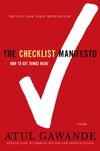
The Checklist Manifesto: How to Get Things Right

I came away from Katrina and the builders with a kind of theory: under conditions of complexity, not only are checklists a help, they are required for success. There must always be room for judgment, but judgment aided—and even enhanced—by procedure.
Atul Gawande • The Checklist Manifesto: How to Get Things Right
O’Sullivan said, was called a “submittal schedule.” It was also a checklist, but it didn’t specify construction tasks; it specified communication tasks. For the way the project managers dealt with the unexpected and the uncertain was by making sure the experts spoke to one another—on X date regarding Y process. The experts could make their individu
... See moreAtul Gawande • The Checklist Manifesto: How to Get Things Right
The first is ignorance—we may err because science has given us only a partial understanding of the world and how it works. There are skyscrapers we do not yet know how to build, snowstorms we cannot predict, heart attacks we still haven’t learned how to stop. The second type of failure the philosophers call ineptitude—because in these instances the
... See moreAtul Gawande • The Checklist Manifesto: How to Get Things Right
He also did something curious: he designed a little metal tent stenciled with the phrase Cleared for Takeoff and arranged for it to be placed in the surgical instrument kits. The metal tent was six inches long, just long enough to cover a scalpel, and the nurses were asked to set it over the scalpel when laying out the instruments before a case. Th
... See moreAtul Gawande • The Checklist Manifesto: How to Get Things Right
That routine requires balancing a number of virtues: freedom and discipline, craft and protocol, specialized ability and group collaboration. And for checklists to help achieve that balance, they have to take two almost opposing forms. They supply a set of checks to ensure the stupid but critical stuff is not overlooked, and they supply another set
... See moreAtul Gawande • The Checklist Manifesto: How to Get Things Right
They trust instead in one set of checklists to make sure that simple steps are not missed or skipped and in another set to make sure that everyone talks through and resolves all the hard and unexpected problems.
Atul Gawande • The Checklist Manifesto: How to Get Things Right
The checklist cannot be lengthy. A rule of thumb some use is to keep it to between five and nine items, which is the limit of working memory.
Atul Gawande • The Checklist Manifesto: How to Get Things Right
It is common to misconceive how checklists function in complex lines of work. They are not comprehensive how-to guides, whether for building a skyscraper or getting a plane out of trouble. They are quick and simple tools aimed to buttress the skills of expert professionals.
Atul Gawande • The Checklist Manifesto: How to Get Things Right
When you’re making a checklist, Boorman explained, you have a number of key decisions. You must define a clear pause point at which the checklist is supposed to be used (unless the moment is obvious, like when a warning light goes on or an engine fails). You must decide whether you want a DO-CONFIRM checklist or a READ-DO checklist.